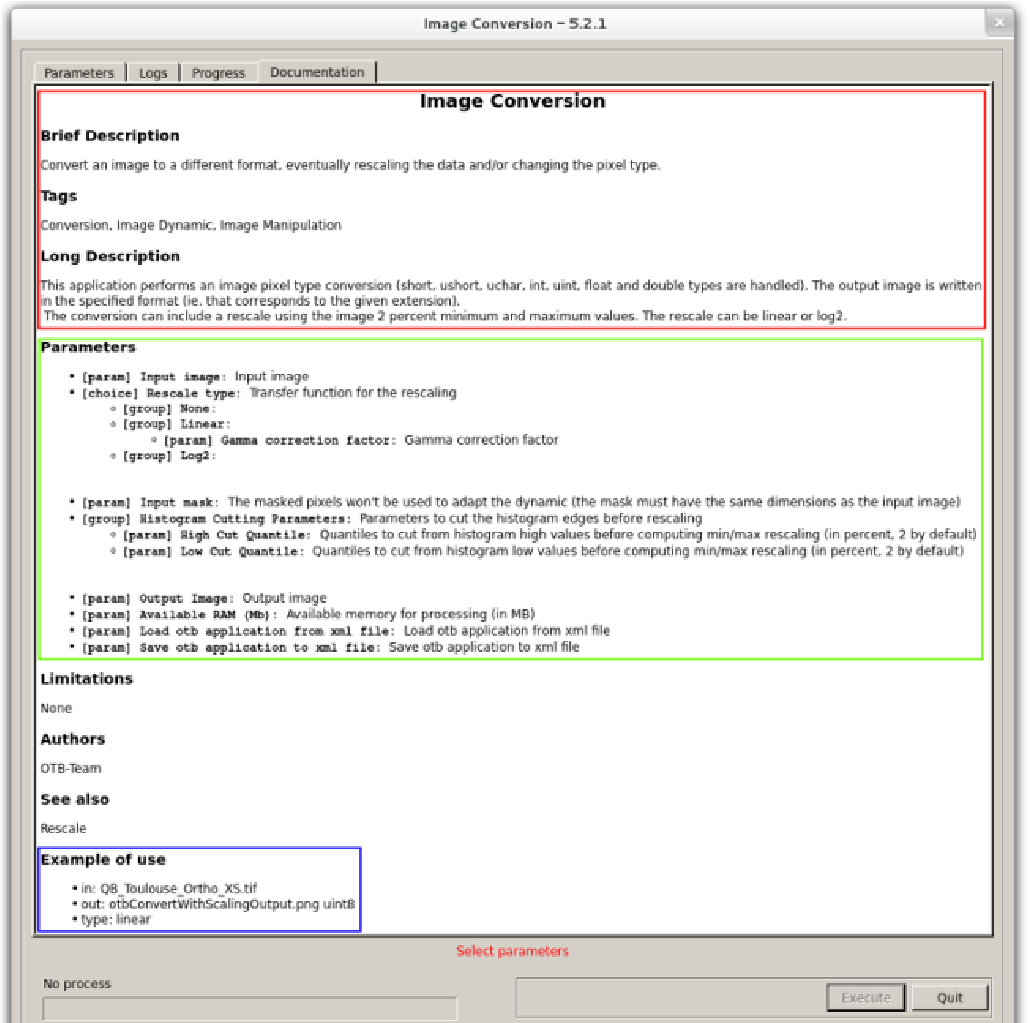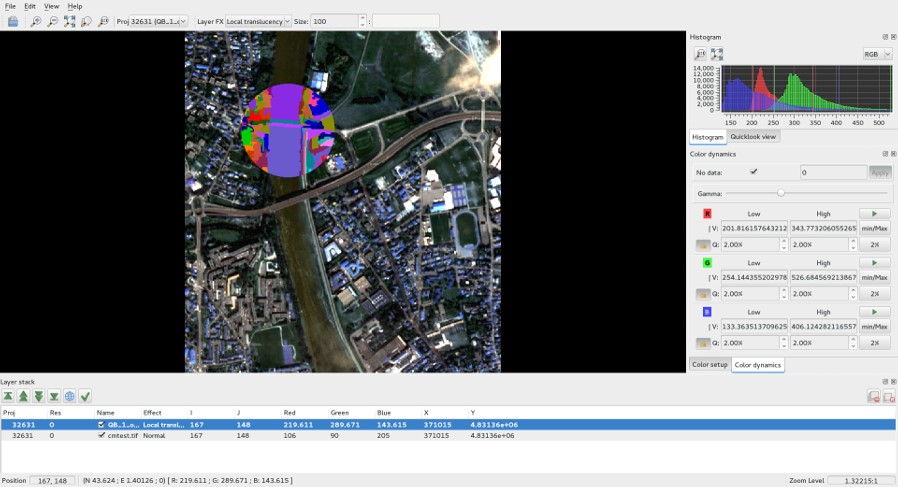20.2. 使用OTB 应用程序#
OTB 应用程序旨在为用户提供许多实现的流程。这些应用程序可以直接通过多接口(命令行、图形界面、Python语言等)使用。 目前,有100多个按不同类别组织的应用程序。
20.2.1. 接口#
原则#
每个OTB 应用程序都包含一个流程,为其参数化和执行提供一组功能。 OTB 应用程序中使用的所有参数都经过标准化和类型化(图像、载体、文件夹、integer、floating等)。 这种形式主义使得任何OTB 应用程序都可以通过各种接口操作。
参数#
OTB 应用程序参数由键(参数的名称)和值标识。有多种类型的参数可用。 如 表 20.1 所示。显示了参数可以采用的不同类型的值。
Type |
Designation |
|---|---|
<int32> |
32 bits signed integer (from ÿ2,147,483,648 to 2,147,483,647) |
<float> |
Simple precision floating point (32 bits) |
<string> |
String |
<string list> |
List of strings |
<boolean> |
Boolean |
如 表 20.2 所示,总结了参数类型及其值类型。
Type |
Value |
Description |
|---|---|---|
Integer |
<int32> |
32 bits signed integer. Example: maximum iterations number. |
Real |
<float> |
Single pecision floating point. Example:distance in cartographic units. |
String |
<string> |
String. Example: field name. |
Strings list |
<string list> |
Multiple strings. |
Input file |
<string> |
A file of any kind, as input to an algorithm. For example: a classification rule contained in a text file. |
Input files list |
<string list> |
Multiple input files. |
Output file |
<string> |
A file of any kind, at the output of an algorithm. For example: a text file containing statistics. |
Folder |
<string> |
A folder accessible on the file system of the machine. |
Choice |
<int32>,<float> or <string> |
|
Input image |
<string> |
An input image, in a format supported by GDAL |
List of input images |
<string list> |
Multiple input images |
Input vector data |
<string> |
An input vector data, in a format supported by GDAL |
List of input vector data |
<string list> |
Multiple vector data |
Output image [Pixel type] |
<string> [<string>] |
This parameter includes a string for the path to the output file and a pixel type for setting the pixel encoding of the output image. We will return to this parameter in section 5.2.2 of this chapter. |
Output vector data |
<string> |
An output vector data, in a format supported by GDAL/OGR. |
Radius |
<int32> |
The radius of a pixel neighborhood, in pixels percolumn and per line. For example: a square structuring element with a radius of 2 × 3 pixels defines a centered neighborhood of 5 × 7 pixels. |
Parameters group |
Multiple parameters |
|
Complex input image |
<string> |
|
Complex output image |
<string> |
Complex output image (e.g. SAR image) |
RAM |
<int32> |
Amount of RAM that can be used by the algorithms (in megabytes) |
InputProcessXML |
<string> |
Extensible Markup Language (XML) file to load the parameters of an execution of the application |
OutputProcessXML |
<string> |
XML file to save the parameters of an execution of the application |
在OTB 应用程序中,任何参数都可能是强制性的。 在这种情况下,如果未输入参数的值,则算法将不会执行,并且错误将报告丢失的参数。 某些参数扫描具有预定义的默认值。 还可以为数字值(整数和真实数字)输入最小值和最大值。
描述#
OTB 应用程序还集成了所实现的处理及其参数的文档。还输入应用程序作者和实现算法的限制。 一个或多个标签可以与应用程序关联,例如:
图像分析;
校准;
变更检测;
坐标;
降维;
特征提取;
图像滤波;
几何学;
高光谱;
学习;
图像处理;
图像元数据;
图像多分辨率;
泛锐化;
光栅;
– SAR;
立体声;
细分;
矢量数据操作。
20.2.2. 命令行界面#
该界面在UNIX(Linux、Mac OS X)上称为“终端”, 在Windows(cmd)中称为“DOS命令提示符”,使其可以通过图形界面调用程序并输出。 一开始对用户不太友好,该界面有很多优点,包括执行批处理的可能性,或自动化多个应用程序的序列。 命令行上使用OTB 应用程序的可执行文件集以“otbcli”为开头。
要在命令行中使用OTB 应用程序,首先可以从应用程序获取帮助。
让我们以 Convert 应用程序为例,它将一张图像转换为另一张图像。
在命令提示符(在Windows上)或终端(Linux或Mac OS X)中,
我们输入以下命令以获取帮助:
otbcli_Convert
与:
otbcli_Convert -help
此命令返回应用程序的描述、预期作为输入的参数以及命令行示例:
This is the Convert application, version 5.11.0
Convert an image to a different format, eventually rescaling the data
and/or changing the pixel type.
Complete documentation: http://www.orfeo-toolbox.org/Applications/Convert.html
Parameters:
-progress <boolean> Report progress
MISSING -in <string> Input image (mandatory)
-type <string> Rescale type
[none/linear/log2] (mandatory, default value is none)
-type.linear.gamma <float> Gamma correction factor
(optional, on by default, default value is 1)
-mask <string> Input mask (optional, off by
default)
-hcp.high <float> High Cut Quantile (optional,
off by default, default value is 2)
-hcp.low <float> Low Cut Quantile (optional,
off by default, default value is 2)
MISSING -out <string> [pixel] Output Image
[pixel=uint8/uint16/int16/uint32/int32/float/double] (default value is
float) (mandatory)
-ram <int32> Available RAM (Mb) (optional,
off by default, default value is 128)
-inxml <string> Load otb application from xml
file (optional, off by default)
Examples:
otbcli_Convert -in QB_Toulouse_Ortho_XS.tif -out
otbConvertWithScalingOutput.png uint8 -typ
从命令行 otbSYS_Convert 获得的 Convert 应用程序参数概述,如 表 20.3 所示。
Name |
Type |
Value |
Mandatory |
Default value |
|---|---|---|---|---|
Progress |
Boolean4 |
<boolean> |
||
In |
Input image |
<string5 > |
Yes |
|
Type |
Choice |
<string> |
“None” |
|
type.linear.gamma |
Floating point number |
<float> |
1 |
|
Mask |
Input image |
<string> |
||
hcp.high |
Floating point number |
<float> |
2 |
|
hcp.low |
Floating point number |
<float> |
2 |
|
Out |
Output image |
<string>[<string>] |
Yes |
pixel=float |
Ram |
Integer |
<int32> |
128 |
|
Xml |
InputProcessXML |
<string> |
“out”参数用于指示输出图像的路径。可选地,可以对 outputpixel 施加编码。
此编码可以按照文件的路径定义,并用空白分隔。正如应用程序所说,编码是一种选择。
如 表 20.4 所示。
Name |
Designation |
|---|---|
uint8 |
8 bits unsigned integer.Values range: [0; 255] |
int16 |
16 bits signed integer.Values range: [¨C32 768; 32 767] |
uint16 |
16 bits unsigned integer.Values range: [0; 65 535] |
int32 |
32 bits signed integer.Values range: [¨C2 147 483 648; 2 147 483 647] |
uint32 |
32 bits unsigned integer. Values range: [0; 4 294 967 295] |
Float |
Single precision floating point (32 bits) |
Double |
Double precision floating point (64 bits) |
备注:
一些图像格式不允许所有编码(例如,一些JPEG2000驱动程序不支持浮点编码)。
当像素的值范围不对应于编码时,输出图像上可能发生信息丢失。
在下面的示例中,指定了路径(“outputImage.tif”)和输出图像的编码(“uint8”)。 输出图像将为TIFF格式(扩展名 .tif ),其像素的编码将为8带符号位(值在0到255之间)。
otbcli_Convert -in inputImage.tif -out outputImage.tif uint8
20.2.3. 图形用户界面#
每个OTB 应用程序还可以通过图形用户界面(图形用户界面)使用。 该图形用户界面可以通过与按钮、可编辑字段和各种其他对话框交互来选择应用程序的参数。 允许我们通过图形界面使用OTB 应用程序的一组可执行文件以“otbgui”为开头。 当使用这些可执行文件时,会自动生成一个窗口并适应OTB 应用程序的内容。 在第一个选项卡中,可以访问应用程序的参数如 图 20.6 。 以下面板允许您关注应用程序的进度(“日志”和“进度”选项卡)。 界面的最后一个选项卡提供了应用程序及其参数的描述。

图 20.6 Convert应用程序的图形用户界面#
当前选项卡允许我们编辑应用程序参数,如 图 20.7 。

图 20.7 Convert应用程序图形用户界面#
当前选项卡提供应用程序描述(红色)、有关其参数的信息(绿色)和使用示例(蓝色)。 有关该图形的彩色版本,请访问 www.iste.co.uk/baghdadi/qgis1.zip
20.2.4. 来自QGIS的使用#
QGIS是一个免费的、开源的、多平台地理信息系统(地理信息系统),根据通用公共许可证发布, 它提供了大量功能:管理大量的载体数据或数据库格式、基于Python的引擎脚本以及允许我们使用QGIS社区开发的模块的插件机制。
OTB 应用程序可以直接从QGIS调用。与上一节中介绍的图形用户界面类似,QIIS动态创建一个窗口,
以启用 OTB 应用程序参数化。
Python绑定#
由于绑定机制,可以使用Python编写的代码来使用OTB 应用程序。 OTB 应用程序可以与Python模块结合用于地理空间目的。还有将OTB 图像转换为NumPy数组的机制, 使OTB 应用程序与Python集成变得更加容易。
Monteverdi#
最后,OTB 包括一个名为Monteverdi的可视化软件。
该软件使我们能够以快速且用户友好的方式浏览图像集(例如系列或马赛克)。
它基于GL着色语言技术来提供实时动态显示功能,并基于OTB 功能来实时配准图像[MIC15]。
Monteverdi还允许完全访问应用程序的图形界面。加载到Monteverdi的图像可以拖放到应用程序中,
执行后生成的图像会自动加载到 Monteverdi 。 Monteverdi 的图形界面,
如 图 20.8 。

图 20.8 Monteverdi软件#
加载两个上沉积图像层并使用局部透明度工具。 有关该图的彩色版本,请参阅www.iste.co.uk/baghdadi/qgis1.zip
值得注意的是, Monteverdi 并不是像QGIS那样的完整地理信息系统软件,
并且仅限于图像可视化和应用程序的简化集成。
对于几何特征编辑或属性表操作等高级地理信息系统操作,建议结合使用 Monteverdi 和QGIS软件。